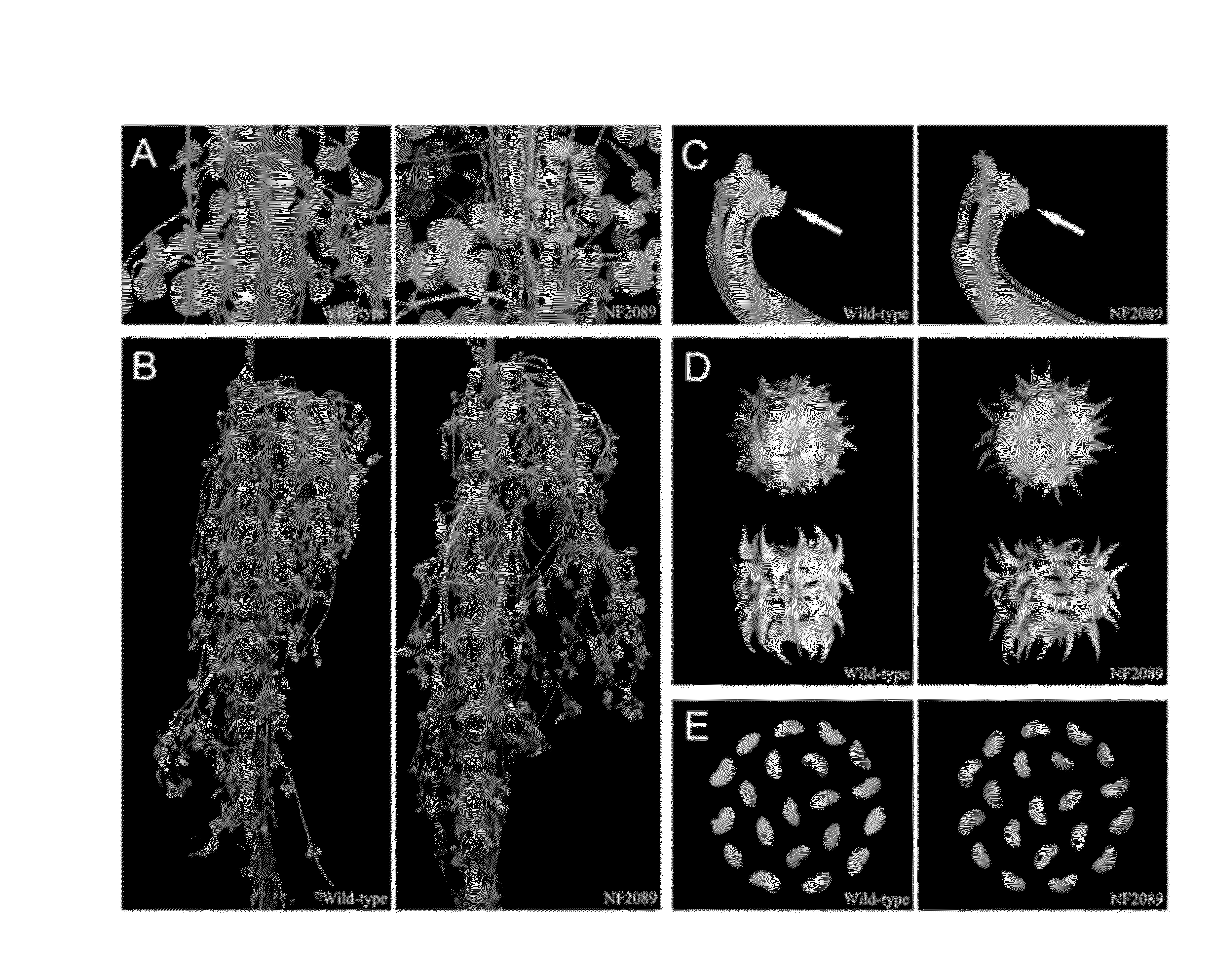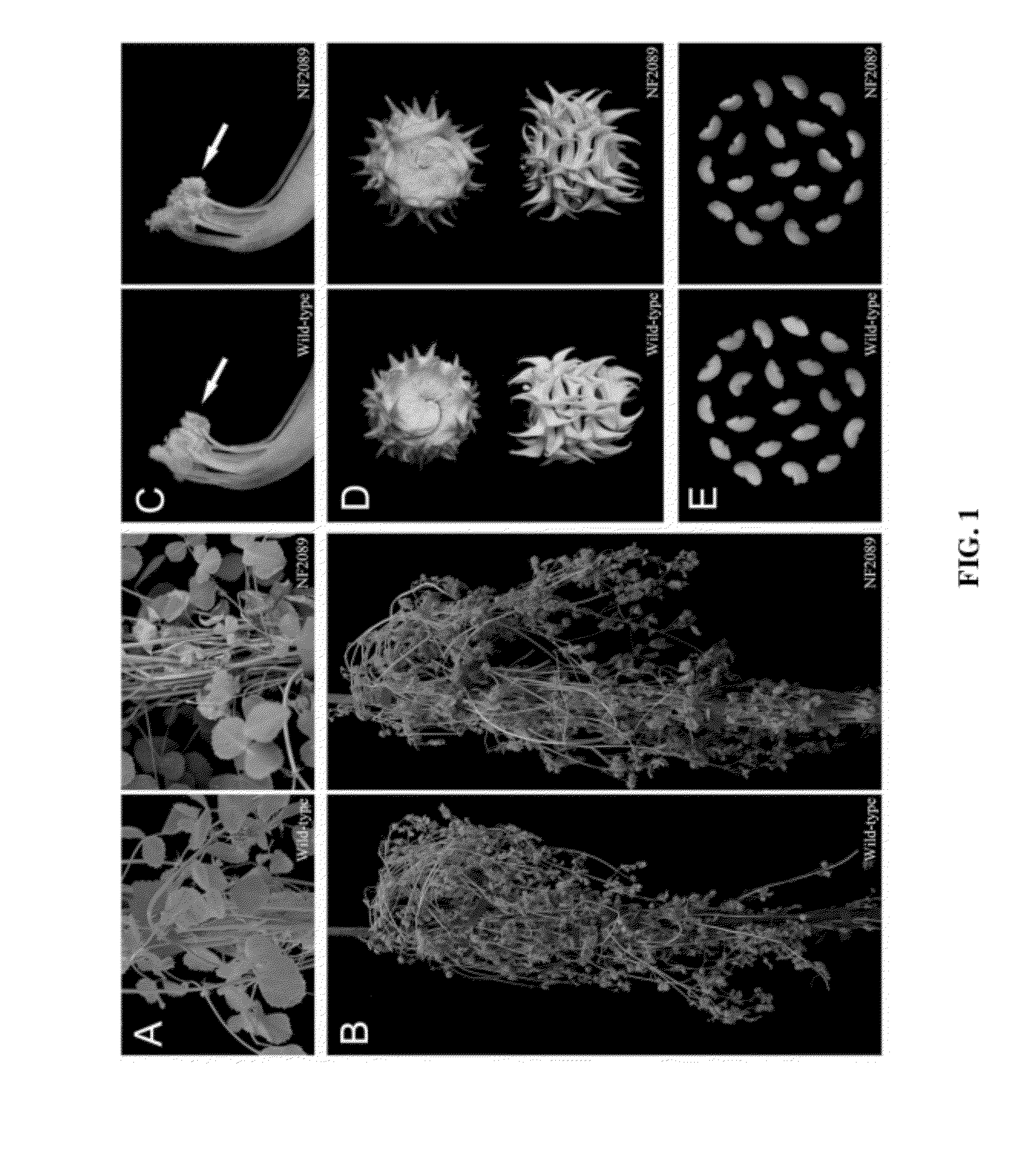Altered senescence for improved forage quality
a technology of forage quality and senescence, applied in the field of genetically modified plants, can solve the problems of reducing market value and yellowing of leaves, and achieve the effects of increasing yield, increasing nutritional content, and increasing chlorophyll conten
- Summary
- Abstract
- Description
- Claims
- Application Information
AI Technical Summary
Benefits of technology
Problems solved by technology
Method used
Image
Examples
example 1
Identification and Phenotypic Characterization of a M. truncatula Stay-Green Mutant During Natural and Dark-Induced Senescence
[0151]During natural senescence, the basal leaves of wild-type M. truncatula (ecotype R108) turn yellow first, and the whole plant became yellowish gradually. However, the basal leaves of NF2089, an M. truncatula Tnt1 retrotransposon-tagged mutant, were identified as not showing senescent yellow color in the same way as those of wild-type plants (FIG. 1A). Moreover, in this mutant the whole plant remained green until the leaves died (FIG. 1B). Interestingly, the stay-green phenomenon was evident not only in leaves but also in other organs such as anther, central carpels (FIG. 1C), mature pods (FIG. 1D), and seeds (FIG. 1E).
[0152]To determine if the NF2089 mutant exhibited a stable stay-green phenotype during dark-induced senescence, detached leaves of the mutant and wild-type were placed in darkness for up to 10 days. The leaves of the mutant remained green o...
example 2
Chloroplast Structure and Activity in Senescent Leaves
[0154]The ultra-structure of chloroplasts and auto-fluorescence of chlorophyll in both wild-type and the NF2089 mutant were examined during dark-induced senescence treatment. Confocal laser scanning microscope (CLSM) was used to observe chlorophyll auto-fluorescence in living and intact mesophyll cells. From CLSM observation, elliptic shapes of chloroplasts with full fluorescence were observed in the wild-type and the mutant (FIG. 3A, C). After 10 days of dark treatment, intensity of auto-fluorescence in wild-type became nearly undetectable (FIG. 3B), indicating severe degradation of chlorophylls. In contrast, auto-fluorescent intensity in NF2089 mutant mesophyll cells remained sufficiently clear that the outlines of some chloroplasts 10 days after dark treatment were observed (FIG. 3D).
[0155]Cross-sections of chloroplasts were examined using transmission electron microscopy (TEM), and no obvious difference in chloroplast structu...
example 3
Molecular Cloning and Characterization of SGR Gene in M. truncatula
[0156]To determine if the stay-green phenotype in the NF2089 mutant was caused by the mutation of a single gene, the mutant was crossed with wild-type, and segregation analysis was performed in the progeny. The F1 plants did not show the stay-green phenotype when detached leaves were incubated in darkness. Segregation was observed in F1 seeds and F2 plants. The ratio of green versus yellow F1 seeds was close to 1:3 (148:457), and the ratio between stay-green F2 plants and non-stay-green F2 plants was approximately 1:3 (46:143) as shown in Table 1.
TABLE 1Genetic segregation analysis of the NF2089 mutantMutantWild-type-likeMutant:NF2089 × Wild-type(green color)(yellow color)Wild-type-likeF1 seeds1484571:3.09F1 plants461431:3.11(detached leavestreated underdarkness)
[0157]Furthermore, all the plants from the green seeds showed stay-green phenotype after dark treatment, while the plants from yellow seeds did not show the...
PUM
| Property | Measurement | Unit |
|---|---|---|
| length | aaaaa | aaaaa |
| temperature | aaaaa | aaaaa |
| pH | aaaaa | aaaaa |
Abstract
Description
Claims
Application Information
 Login to View More
Login to View More - R&D
- Intellectual Property
- Life Sciences
- Materials
- Tech Scout
- Unparalleled Data Quality
- Higher Quality Content
- 60% Fewer Hallucinations
Browse by: Latest US Patents, China's latest patents, Technical Efficacy Thesaurus, Application Domain, Technology Topic, Popular Technical Reports.
© 2025 PatSnap. All rights reserved.Legal|Privacy policy|Modern Slavery Act Transparency Statement|Sitemap|About US| Contact US: help@patsnap.com



